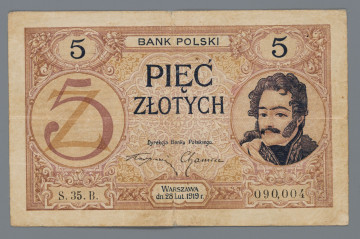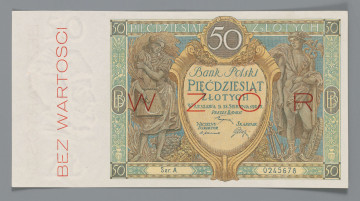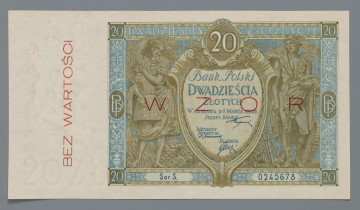
5 zlotys
1919
National Museum in Lublin
Part of the collection: Paper money during the Second Polish Republic
The end of the first decade of the Polish state, reborn in 1918, brought a radical deterioration in the economic situation. It was related to the global crisis that began on 29 October 1929 on the New York Stock Exchange. Poland was among the countries most affected by the crisis. This was connected to the Polish government's maintaining the convertibility of its currency into gold and its reluctance to propose a devaluation of the zloty. The fact significantly hindered an active policy of counteracting the effects of the crisis and delayed economic stimulation for a long time. As a result, the crisis in industry began to be overcome in 1933, and it was not until 1935 that we could speak of an end to the depression. Even so, as late as 1936 the value of production in the Polish economy reached just 72% of the 1929 level.
Despite the government's reluctance to save the Polish economy through increased printing of money, new issues of banknotes were constantly put into circulation. One of them was a 100-zloty banknote with a characteristic image of an oak tree on the reverse. The first decision to issue this denomination was taken on 2 June 1931. Less than two months after its introduction into circulation, which took place on 15 September 1934, a second issuance was decided. The banknotes of both issues continued to circulate until 31 January 1940, i.e., during the first months of the German occupation. Some of the 100-zloty banknotes remained in circulation until 20 May 1940, after having been printed accordingly by the authorities of the General Government. The designer of the banknote was Józef Mehoffer, an eminent painter and graphic artist of the Young Poland period. The plates used for printing were made by Włodzimierz Vacek (obverse) and Professor Eugène Gaspé vel Gasperini, a French engraver from Parma, Italy (reverse).
Watermarks were a special feature of the 100-zloty banknotes. Apart from the main motif in the form of an image of Queen Jadwiga and the value numeral placed at the margin, some banknotes bore marks in the shape of consecutive +x+ signs, while banknotes of the second issue also bore small vertical lines. The presented specimen belongs to a later issue and does not have additional watermarks.
Leszek Poniewozik
Author / creator
Dimensions
cały obiekt: height: 176 mm, width: 99 mm
Object type
paper money
Technique
Material
paper
Creation time / dating
Creation / finding place
Owner
The National Museum in Lublin
Identification number
Location / status

1919
National Museum in Lublin

1925
National Museum in Lublin

1926
National Museum in Lublin
DISCOVER this TOPIC
Castle Museum in Łańcut
DISCOVER this PATH
Educational path